
Farewell Korea, jambo Kenya with @pzaich
Recently I stumbled upon an article from the New Yorker called Louis Menand: The End of Homework. As a teacher, the philosophical battle over assigning homework versus not is continuously pumping through my veins. Most of us know the obvious however that worksheets and filler homework is a waste of everyone’s time. I agree with that for sure and I also agree that kids need to be kids and therefore have time to play and to relax.
That being said, I don’t know if abolishing all homework is the right answer either. In my opinion, the work that I assign students is purposeful and is used to review concepts or give them individual time to write without their classmates in the same room. Three items that I find valuable as homework are reading, math, and 20 minutes of writing. While I will raise my hand and admit guilt, that I do assign more homework than those three items, this article made me think twice about that avenue.
Each night I get an email saying a student forgot this at school or his or her computer would not work to do their blog post. If students had an hour in class to complete their work, then these questions would not arise. That said, with so much material to cover as a teacher, some times it seems impossible to give students that luxury.
But, would it be the worst thing to get through less in order to give students a break at home? Teaching is South Korea, I see first hand the stress that my 10 to 11 year olds are under due to the pressure from home and society. To allow students to take a break (not overload them with work), would be ideal.
Heading to break, I think that I will come back and try out sticking to my word about only have students practice math, reading and writing at home for a limited amount of time. Looking forward to posting about my success and failures in thinking through my own philosophy on homework.
With winter break only four days away, I wanted to find a lesson on online etiquette or as it is now deemed—netiquette. I am motivated to be sure that my students are operating as good digital citizens since I know that they are respectful, kind ones in person. That being said, the difficulties with online interactions are heightened by the anonymity of interacting online. It is hard for kids to see the human side to texting, chatting, or emailing when they can’t see the person’s face. I am going to be starting to use the commonsense media lessons for grades 3-5 beginning in January as a way to build into my tech innovation the importance of digital literacy and common sense.
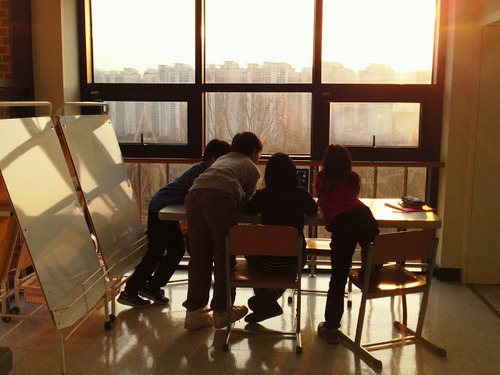
Today it was such a joy to officially have our novel study groups Skype with Springer School in Los Altos. Each group had one computer, and about 30 minutes to discuss their novels. Overall I would call it a succes as we only had a few technical hiccups where video dropped out and we had to go to imessaging back and forth instead. While I don’t think there was intense intellectual discussion, it made my heart soar to watch my students interacting with 12 year olds in another country.

The power of technology at our finger tips is incredible. To be able to work with people you’ve never met as an adult is useful and as a kid it is like magic. I am incredibly proud of my students and how they adapt and and run with lessons I give. At times I forget how young they are and today I was just so proud of their ability to adapt to technology. See here for links on our class website to their blogs where they discuss their own reactions to the Skype session today.
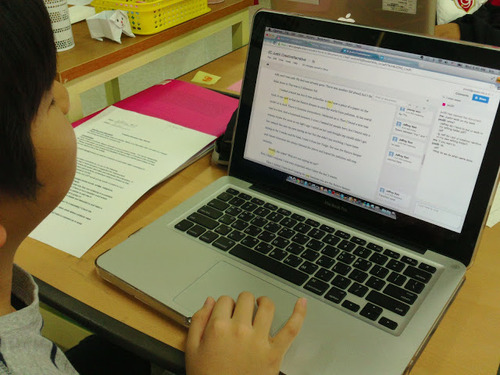
All this being said, today we had our first snow in Korea. At the end of the day, I noticed all of us were more excited about snow than math so we put aside our computers, pencils and paper and took time to just be kids. Playing in the white powder snow was an incredible feeling! We were all kids without any cares in the world.
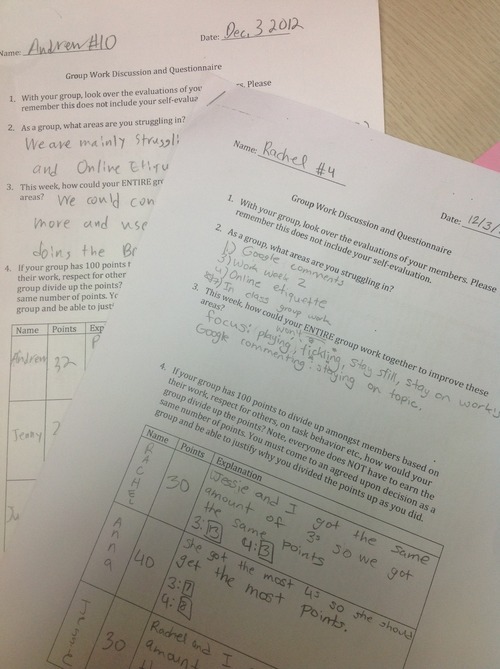
It is always hard as teachers, for us to judge how well our students work in groups. As we meet with various teams, inevitably we miss what occurs in the others. So, rather than evaluate the groups myself, for our novel studies, I asked my students to work together to evaluate each other.
Last week, students filled out an online Google Form where they self evaluated as well as evaluated their group members. Then I took the data and created an excel sheet with the names of the students and their evaluations next to them (see below).

Students were then given a handout with the following questions:
In their group, they worked together to answer the above questions. Listening to the conversations of the students I noticed the following both positive and negative:
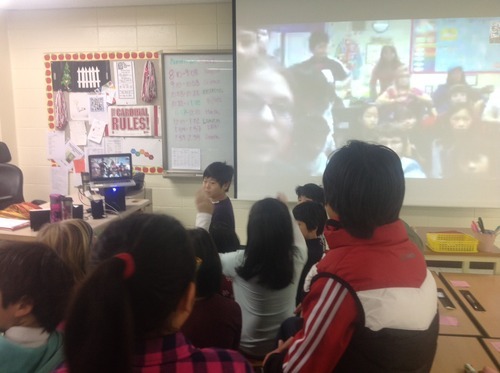 Today, my students in Korea had the wonderful opportunity to Skype with Springer School in Los Altos, California for our Trans-Pacific Book Club. It was such a thrill to see the faces of my students light up as they spoke face-to-face with their book club members. Technology like Skype, FaceTime, and Google Hangout, make it possible to share experiences with people across oceans.
Today, my students in Korea had the wonderful opportunity to Skype with Springer School in Los Altos, California for our Trans-Pacific Book Club. It was such a thrill to see the faces of my students light up as they spoke face-to-face with their book club members. Technology like Skype, FaceTime, and Google Hangout, make it possible to share experiences with people across oceans.
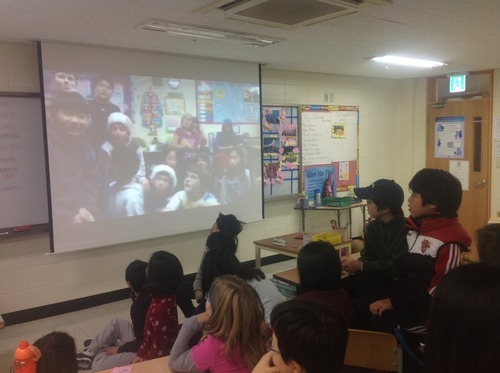
I think the biggest hurdle with video chat using any provider is the technical difficulties. Having tested Google Hangout yesterday, I knew that I needed one student in each group to install the video/chat plug-in or else it would not work. However, even though we tested each student with my own Google Hangout, we did not test with Los Altos. The other teacher and I came to the conclusion that the Google Apps for Education in Los Altos might be blocking that feature. Name of the game, make sure you test prior to and always have a back up plan.
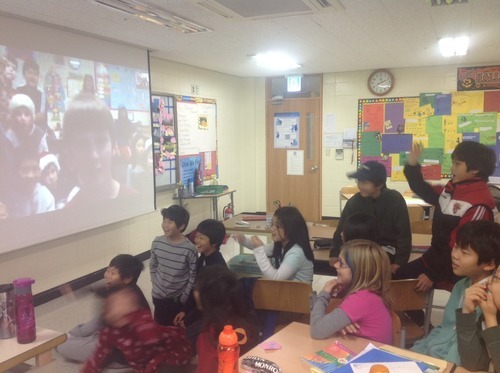 We went to our back up plan with only about 15 min left to chat. Rather than having each novel study group video chat with each other, we went with a whole class chat using Skype. It worked great and the kids were none the less excited to meet each other virtually for the first time.
We went to our back up plan with only about 15 min left to chat. Rather than having each novel study group video chat with each other, we went with a whole class chat using Skype. It worked great and the kids were none the less excited to meet each other virtually for the first time.
We’ve scheduled two other video chat sessions where the students will be discussing their novels in more depth. Julie and I will be testing prior to that using Google Hangout.
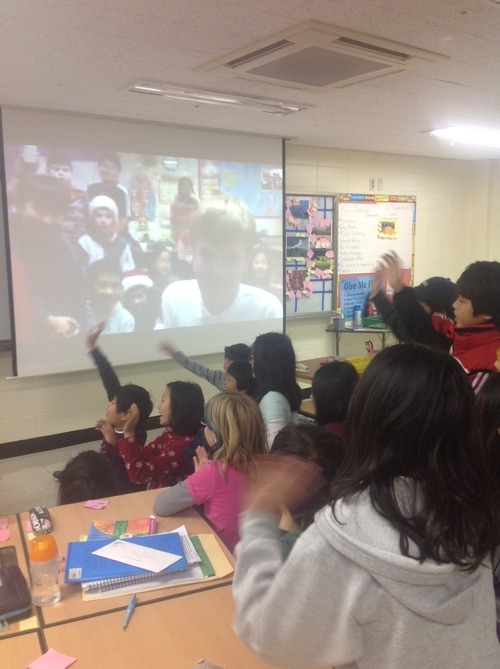 Having minimally used video chat in the classroom, I’ve been looking into how to use it for other educational purposes. See below for some ideas I’ve pondered on using video chat in classrooms:
Having minimally used video chat in the classroom, I’ve been looking into how to use it for other educational purposes. See below for some ideas I’ve pondered on using video chat in classrooms:
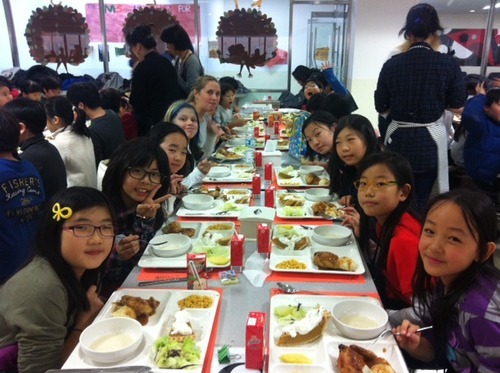
While Korea doesn’t celebrate American Thanksgiving, today at lunch we had a feast fit for any suburban family. Complete with Costco pumpkin pie, turkey, corn, mashed potatoes, and salad, it was a lovely time.
Throughout the meal I was admiring the kindness of my students and thinking about all that I am thankful for in my life. So I decided it would be applicable to write an education blog post about all the edtech tools I am thankful for:
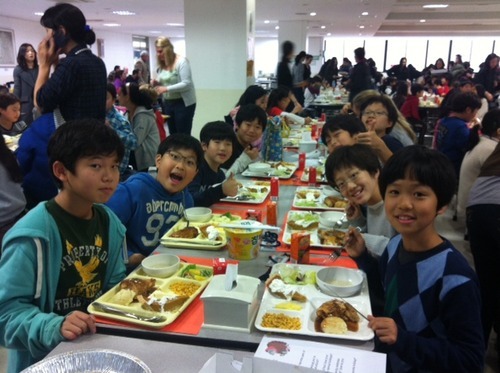
Teaching students how to use HTML to embed a video into their blog post. It is important that students realize websites are made possible by more than just their typing and pressing buttons. Hoping to have my husband introduce some basic coding skills as well in the near future. Enjoy the screencast and check out other blogger screencasts here.
Wednesday proved to be a low point in my patience level. In our reading groups, students are working collaboratively on a Google doc. While in class, I had students who did not read the right pages even though they were explicityly stated on the Google doc. Additionally, I had assigned a screencast video on how to add labels to blog posts and how to copy and paste a Google doc into blogger so it was properly formatted. However, upon checking over their work I had about half my class forget to do one blog post.
Bubbling up to the surface, I felt a great amount of annoyance that the kids did not follow directions. I realized that they are only 10 but in the moment during class I just couldn’t handle it. Clearly they sensed my frustration and most were very quiet during the remaining part of the class period.
After the kids went to lunch, I sat at my desk and had a personal reflection period due to feeling incredible awful in regards to loosing it with my kiddos. I am trying to teach them how to use Google docs, learn independently, create Google forms, write blog posts with tags, upload Google docs, insert images, create iMovies, use Today’sMeet, watch Khan Academy videos on unknown math concepts so I can flip the classroom, work on Edomodo with students in California, and still remain kids.
I am out of breath simply typing all that I have asked of my students. So upon this realization, I feel that I need to have grace with them when issues come up. Many of these kids never used Google docs before August of this year and now they are soaring. I am impressed inside and out with how much technology they have learned and been able to apply across the subject areas.
If I think back to my fifth grade year, I remember non of the types of projects I am having my students work on now. My hope is that they look back on this year and feel they truly learned skills that they will utilize beyond 5th grade.
On that same note I hope that they remain kids this year too. I wonder if I push too hard at times and expect too much. Hopefully reading picture books takes care of that : )
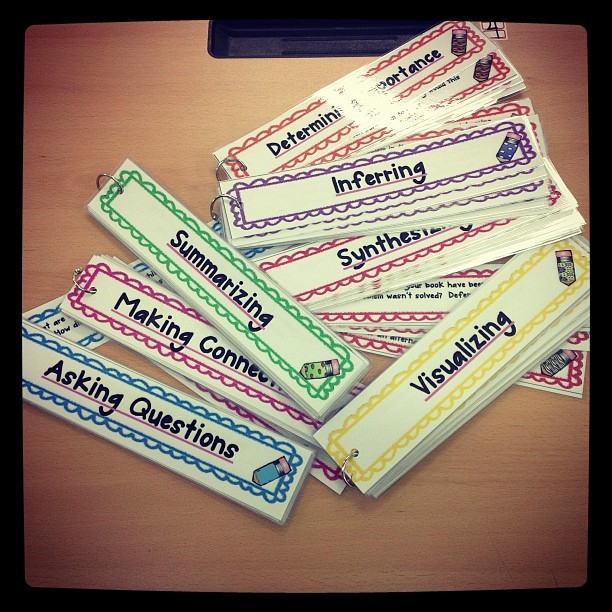
Sometimes what we need is a bit of lamination, paper and scissors. Reading card choices, thank you Angela!
My students each have their own blog. Sometimes issues come up at home or in class that I don’t have time to explain. By making a screencast or a “How to…” video on a topic such as inserting an image, copying a Google doc over to the blog etc. I limit the in class time spent on a task students can do at home. Some of the videos are softer in volume than I’d like, but that all comes with practice. Check out my YouTube playlist on Blogger how tos here.
Presentation for our PTO showcasing the technologies I am using in my grade 5 classroom.
Humanizing the classroom—see the individual in the classroom by using technology to differentiate, to innovate and to provide interaction amongst students. Check out the full TED talk by Sal Khan here!

Peppero day in South Korea. So many treats from my kids : )
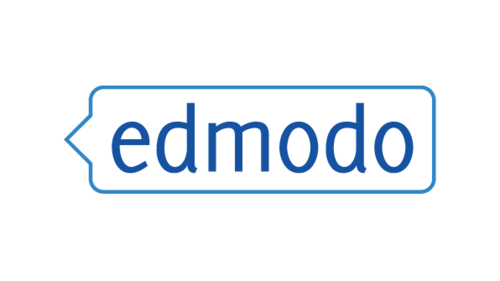
Currently, I am undertaking developing a trans-pacific book club with Springer Elementary’s 6th grade class in Los Altos California. Being at a global international school, my students in Korea need to be able to learn how to interact with people in other countries using technology.
With a husband who freelances for US companies doing programming, I am well aware that no longer do you need to work in the same location as your colleagues. Thus, I want to prepare my students with the understanding that they can communicate with people who are very far away.
The other teacher in California and I have put together small discussion groups using the small group feature on Edmodo as a way for students to post their literature discussion questions and have multiple people respond to them.
In addition to Edmodo, we have created a Google doc where all members of a book club group will add information as they read. Information will relate to the main events, inferences, vocabulary, discussion questions, theme and more. Using the comment feature, which both she and I have taught our students how to use in a constructive way, students will be able to add onto what others say as well.
Today, students took time to use Google spread sheets to create a rubric on which they will grade themselves. By allowing students to be able to self assess, they will take more ownership over their own work since they know exactly what they will be assessed on. Normally, I would give this rubric out, but having students create one gives them a deeper understanding of the purpose of using them.
During this time, my students will be blogging about their novel as well. We will then take their blog content and create a digital newspaper as one of our final projects using paper.li. Additionally, we plan to have two to three Skype, face time or Google hangout sessions so groups can discuss their novel face to face.

As an aspiring edtech jedi, I began my training in the Dagobah System or rather in the html code and teachings of Blogger. Guided by my Yoda master at school, he spoke to me with great wisdom, “Do or do not there is no try.” So do I did. Back in September, I laid out a lesson with my edtech master Tim Bray who is full of great strength and great wisdom. Together we would conquer the Blog.
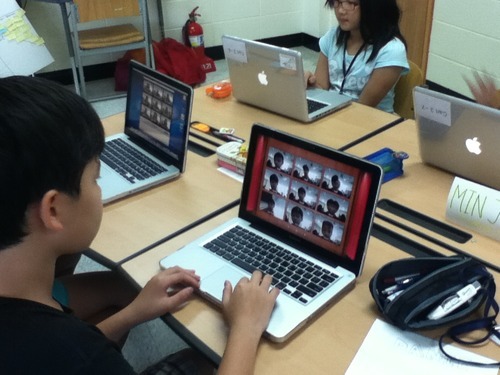
My process for teaching 16 fifth graders how to use Blogger was very simple and I was heaviliy relying on the fact that they were already very used to using google docs and other google products.
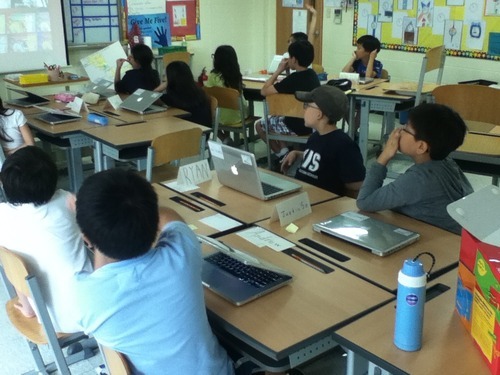
Here is a link to my lesson plan for setting up a blog on lessonopoly.org. Below is a general outline of what I did in my lesson (1 hr):
Currently students write about two to three blog posts a week on a variety of topics. Generally I use their blogs for weekly reading letters each week and then the other posts vary. Sometimes students will watch a TED talk and then respond to it or they will share something they learned that week in class.
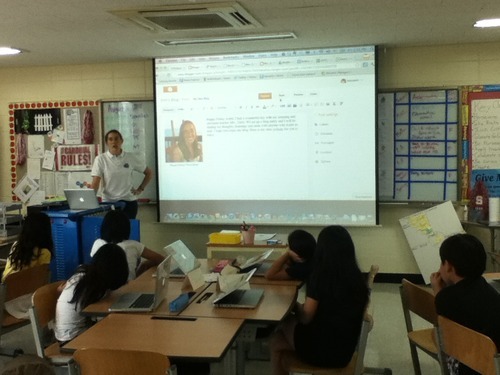
Students enjoy blogging because it gives them a way to read other studnets’ work, share with a wider audience, have a reflective space, and work on their writing skills.

"Could I just air drop it to him?" comment from students when creating book trailers in class. Critical thinkers always find an easier way to work together therefore using time in class more effectively and efficently.
Being in Korea, almost every student in my class has a smart phone. Now, I know that they are experts in using them, so why should I not tap into their excitement in being able to use their phones in class?
I already allow them to use their devices during a word study period in which once a week they have to look up the definitions of words they are analyzing. Taking this into consideration, I decided to figure out a way to use them in my lesson on people’s access to clean water around the world.
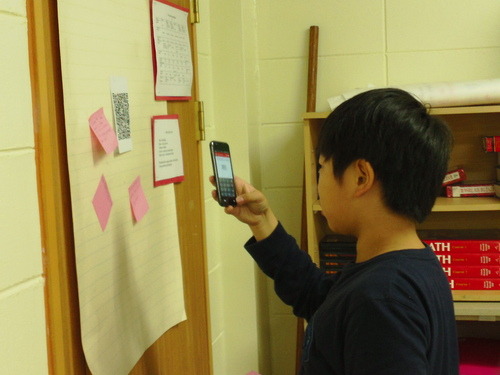
Now, also in Korea, there are QR codes everywhere you can imagine. Thus, I knew my students would be familiar with what they are. Rather than just printing off photos from National Geographics phenomenal website on freshwater and the environmental issues surrounding it, I wanted a way to have my students react authentically to them, in essence to be surprised.
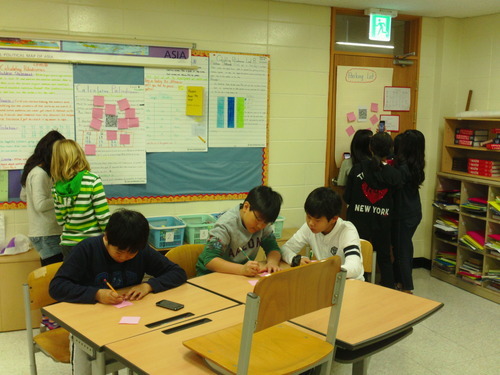
I decided to change the photos from National Geographics gallery on Freshwater Conflict photos, by pasting their URL into a QR code generator, like this one here. Then, I printed off the images of the QR codes and hung them around the room. Students, with a partner, silently took their device around the room and using the Red Laser app, scanned the codes. They then answered three items on post-its about the photo: 1) how does it make you feel? 2) What did you learn? 3) Do you have any questions?
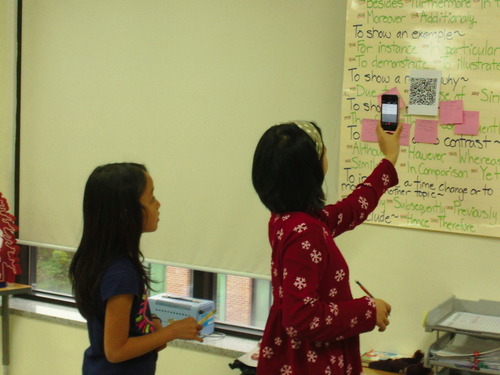
They would put up the post-its by the QR code and then wander to another station in the classroom to check that one out. It was remarkable to see the students working together to figure out how to use the QR codes and reading about the photos on their phone. Because many of the students had never thought about the scarcity of water, this was an incredibly powerful activity that sparked a great discussion.
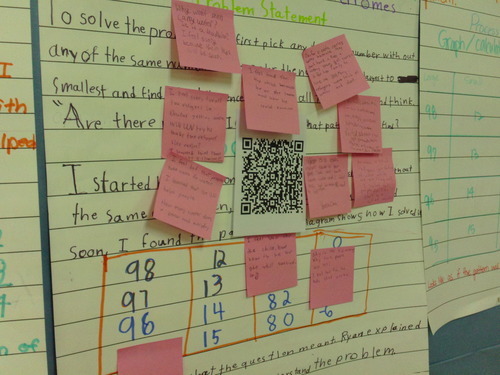 Additionally, students came back to their desks to find a fact about water. Something such as, “More than 3.4 million people die each year from water, sanitation, and hygiene-related causes. Nearly all deaths, 99 %, occur in the developing word,” from water.org.
Additionally, students came back to their desks to find a fact about water. Something such as, “More than 3.4 million people die each year from water, sanitation, and hygiene-related causes. Nearly all deaths, 99 %, occur in the developing word,” from water.org.
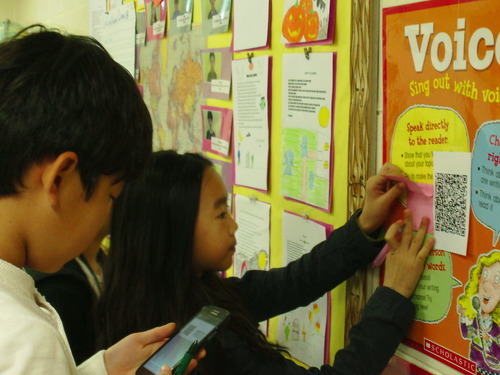
For our next two lessons on water and its scarcity, we’ll be reading the book One Well by Rochelle Strauss and then we will read non-fiction articles on water use in Africa, the importance of water and more. Articles can be found in many major newspapers on water and it is a wonderful way to have students read non-fiction which is becoming a bigger necessity as people must be able to take information from other sources and apply information or formulate opinions. Students will write their reactions to the article, what they learned, what they didn’t understand, and what they’d like to know more about.
Finally, we will analyze info-graphics about the use of water around the world and then take the information we learned in our non-fiction articles and create our own info-graphic as a class. Check out our website for some I downloaded off a pintrest search for water infographics.
Wow, wait, what? Many times I have found my students coming to class after watching a conceptual video done on Educreations or Khan academy and are still striving to grasp the concept of mathematics that was taught.
Flipped teaching has worked wonders in my fifth grade class, allowing me to better differentiate and keep up with kids using the coaching features on Khan academy. But there is more to flipped teaching than just watching videos at home and working on problems in class.
Understanding the hows behind mathematics is key. This past month I have begun to use Today’s Meet at the start of my math class as a place to post conceptual questions. Right now I am creating the questions for the students about the math, but in the future I hope to have them create their own. As a table group, the students then discuss the questions with each other thus increasing their abilities to also discuss mathematics verbally. Next, student are called on to explain a question to the group.
Throughout this time, each group has one computer set up that allows them to put in answers on Today’s meet or ask questions. An alternate to using todays meet is to make a simple google presentation with the concept questions on a slide and then share this with one student in each group.
The next step is to give practice problems. I allow students to work collaboratively on these and will pull small groups during this time if needed. Additionally, sometimes this time is used for a project or a more open ended math activity like ones found on illuminations or the Silicon Valley Math Institute website.
Overall, I am incredibly happy with the structure of my math class now. Each day needs tweaking and shifting and there are times where I simply wish I had another hour with them, but as a teacher it is good to reflect and be open to change because as we know change keeps us growing and learning just like our students.
Photo source: http://www.flickr.com/photos/ajc1/8144344750/
Great video to use with teaching about water usage around the world and the importance of conservation.
Last night at about 10 pm, I received an email from a student kindly and maturely explaining that she was utterly confused by dividing decimals into other decimals. Only an hour or so prior to this, I had g-chatted a student who also was in a pickle about dividing decimals.
I scratched my head and decided to watch the Khan Academy math video I had assigned one more time to asses it for confusing pieces. After watching it through, I discussed it with my husband and we came to the conclusion that while I understood the video, a 10 year old at home with only Mr. Sal Khan and his or her math notebook for guidance might find the video confusing.
Post video assessment, I logged onto Khan Academy to view the work of my students (one of the many benefits of using Khan academy both in and out of the classroom is that one can actually see the modules that students are struggling on, haven’t started, are proficient at or need to review). Once I found the two selected modules I had assigned, I noticed that quite a few students had been struggling. What I also noticed is that quite a few students seemed to give up after a few problems.
At this point two thoughts crossed my mind 1) Did they give up because they truly didn’t understand? or 2) Did they give up because they wanted the answer spoon fed to them?
My biggest cultural shift since coming to Korea as a teacher, has been realizing that my students truly need to learn how to critically think about their work, understand why something is the way it is, and then apply their knowledge.
That point aside, I brushed my teeth, put on my PJs, and hopped in bed with my ipad and stylus. Then I opened up Educreations and started making a video for my students regarding dividing decimals. What I realized was the kids needed a real life situation to think about dividing decimals in and they also needed a simpler problem in which to first learn the concept.
Upon arriving at school, we watched the video as a class. As the kids watched the video, I watched their faces. It seems some concepts were sinking in, it seemed that some questions were cleared.
I am a firm believer in the power of explanation and Educreations makes it incredibly easy to explain a concept exactly as you would like your students to understand it. Additionally, there is great worth in exploring Educreations in general as there are many videos already created by other teachers that you can use.
Using Educreations in congruence with Khan academy also makes even more magic happen.
It is always an exciting day when I get an email from an Apple Distinguished Educator at my school inviting me to an Apple Meetup! This Friday was an incredibly exciting topic, imovie, as I have created several projects this year. I was eager to hear some ideas from other educators on the philosophy behind imovie and the impact it can have on education. Upon arriving, I found about 20 other excited educators ready to discuss imovie. As we shared movies we’d made, a little part of me was really hoping to have a deeper discussion on why we use imovie and what benefits or difficulties we see in it.
Because I wanted more, I went online and found some interesting commentary on using imovie. But mostly I’ve realized that each educator can use technology differently and for various purposes. I think the key is the word purpose. Technology is as effective as the purpose behind using it.
I’ve enjoyed exploring imovie with my students. Here are some of the ways I’ve utilized imovie in my grade 5 classroom:
Ideas for the future:
Tools I want to try in relation to movie making:

Working with @pzaich at #cafebene in Sunae. Love my Sundays
 Today was a day where I realized that being a teacher first and foremost is teaching students how to be caring individuals and that takes no edtech at all, only some patience and love.
Today was a day where I realized that being a teacher first and foremost is teaching students how to be caring individuals and that takes no edtech at all, only some patience and love.
Sometimes we say things we don’t mean, we don’t let other kids play with us at recess, and while to adults it might not seem a big deal—to a 10 year old it feels like an ominous dark cloud will never lift from above her.
That sad face that Eeyore wears, is one I was greeted with after lunch by a few of my students. Gathering all my strength and patience, I readied myself for a battle of tears and girl drama. We had a girl pow-wow in the hall.
After a bit, out spilled the tears and out spilled the sadness and the guilt. Surfaced the bullying on gchat, the exclusion at recess, and the hiccups from so many tears. It seems that even the sweetest girls are capable of exclusion without even realizing what they are doing.
I shared my own stories from 5th grade when I bullied another girl without even knowing why I was doing it. Then I shared how in middle school I was bullied and even though back then I didn’t call it that, I knew exactly how my students felt on both sides of the coin.
It never feels good to have someone exclude you and it feels even worse to realize you did the excluding.
An even bigger issue for me was realizing that the tears these girls are shedding don’t stay behind on the soccer field during recess in 5th grade, but follow us throughout our adult life. Even as an adult, I know the struggle to be accepted by others and the sadness that you feel like an outsider. We sometimes forget that even in grade 5 we feel the same emotions we feel as adults when we don’t get invited to a party or think people don’t think we are cool enough.
The bullying that happens when we are 10 and when we are 30 can take on so many avenues via technology (gchat, texting, email, facebook etc. )
Today I saw the necessity of teaching digital citizenship. We must make sure students know how to operate as digital citizens so cyberbullying and real life bullying can subside.
Commonsense media is an excellent resource for parents and teachers in teaching how to be a digital citizen. With lessons and parent advice it has a wealth of information.
And while I don’t have my own kids, I do have 16 from 8 am to 3 pm. I want these kids to understand the hurt that happens on line and to realize the need to say sorry and to forgive through tears and guilt.

Check out some amazing How to … videos from my 5th grade class. We used imovie, creative commons, and cameras to make short videos teaching someone something new. Our class plans to enter them in a great contest through Next Vista for learning. Scan the QR code or use this link to get to our class You Tube channel where you’ll find other great videos to learn from.
This past Friday I presented at KORCOS, a conference near Seoul for international schools. Here are my slides that explain the use of using screencasting with essay correction to enhance student engagement.
Do you feel like your students fail to fully engage and build upon the red lines, scribbles and notes that you jot down on their essays? In this session, Use video to provide active feedback on writing by combining visual and auditory learning with video essay feedback. This session will consist of two parts. 1) How to .. 2) The purpose behind the technique.
Participants will view digitized videos of feedback on writing and compare them to hand written comments or even to electronic feedback, assessing the pros and the cons of each.
Experiment with technologies like EduCreations and Quicktime screencasts as tools to creating real time video feedback. This will be a hands-on workshop and all participants are encouraged to bring computers and/or iPads and stylus. By the conclusion of the session participants will have the basic skills to create their own video feedback sessions for their students and will understand the fundamental benefits that can be derived from this process. See here for an example using educreations, and here using quicktime.